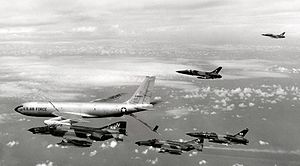
Back عملية الظهير Arabic لاینبکر عملیاتی AZB Аперацыя «Паўабаронца» BE Operation Linebacker German Operación Linebacker Spanish عملیات لاینبکر FA Operaatio Linebacker I Finnish Opération Linebacker French Operazione Linebacker Italian ラインバッカー作戦 Japanese
| Operation Linebacker | |||||||
|---|---|---|---|---|---|---|---|
| Part of the Vietnam War | |||||||
 A 388th TFW SAM hunter-killer team refueling on its way to North Vietnam, October 1972 | |||||||
| |||||||
| Belligerents | |||||||
|
|
| ||||||
| Commanders and leaders | |||||||
|
John W. Vogt Jr.[4] Damon W. Cooper[5] | Nguyen Van Tien[citation needed] | ||||||
| Casualties and losses | |||||||
|
in combat or operational accidents[6] (excluding the number of aircraft that were badly damaged beyond repair[7]) North Vietnamese claim: 651 aircraft shot down, 80 warships sunk or damaged[8] |
U.S. claim: 63 aircraft shot down North Vietnamese claim: 47 aircraft shot down (26 MiG-21s, 5 MiG-19s and 16 MiG-17s)[9] | ||||||
Operation Linebacker was the codename of a U.S. Seventh Air Force and U.S. Navy Task Force 77 air interdiction campaign conducted against North Vietnam from 9 May to 23 October 1972, during the Vietnam War.
Its purpose was to halt or slow the transportation of supplies and materials for the Nguyen Hue Offensive (known in the West as the Easter Offensive), an invasion of the South Vietnam by the North Vietnamese People's Army of Vietnam (PAVN) that had been launched on 30 March. Linebacker was the first continuous bombing effort conducted against North Vietnam by the US and South Vietnam since the end of Operation Rolling Thunder in November 1968.
- ^ "How Nixon's Operation Linebacker Countered North Vietnam's All-Out Bid to Conquer the South". HistoryNet. 5 April 2022. Retrieved 7 November 2023.
- ^ Haun, Phil; Jackson, Colin (2015). "Breaker of Armies: Air Power in the Easter Offensive and the Myth of Linebacker I and II in the Vietnam War". International Security. 40 (3): 139–178. doi:10.1162/ISEC_a_00226. ISSN 0162-2889. JSTOR 43828564. S2CID 57564546.
- ^ Pribbenow, Merle L. (2001). "Rolling Thunder and Linebacker Campaigns: The North Vietnamese View". The Journal of American-East Asian Relations. 10 (3/4): 197–210. doi:10.1163/187656101793645524. ISSN 1058-3947. JSTOR 23613043.
- ^ Thompson, p. 257.
- ^ Thompson, p. 257.
- ^ Ed Rasimus (2006). "Appendix I – Linebacker Losses". Palace Cobra: A Fighter Pilot in the Vietnam Air War. St. Martin's Press. ISBN 978-0-312-35356-8., pp. 233–248. Losses are enumerated by date, aircraft type and serial number, and crew members.
- ^ Drenkowski & Grau 2007, p. 3.
- ^ Van Thai & Van Quang 2002, p. 301.
- ^ "Archived copy". old.vko.ru. Archived from the original on 3 February 2014. Retrieved 11 January 2022.
{{cite web}}: CS1 maint: archived copy as title (link)